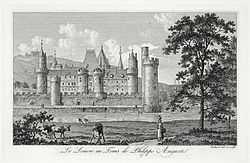Tour du coin
Coordinates: 48°51′33.46″N 2°20′16.67″E / 48.8592944°N 2.3379639°E

The tour du coin (=tower of the corner) is one of the main towers of the ancient wall of Philippe Auguste in Paris, built between 1190 and 1209.
The towers of the corner
The corners of a medieval fortress were sensitive parts, because easier to attack and hard to defend. And when the enemy reached the top of the wall, he was hidden by pieces of masonry and hard to repulse.
So, the "towers of the corner", as they were called, had to be very strong. They were built larger and taller than the other ones. At the bottom of these towers, there were wider ditches, fences, and sometimes advanced forts or bastions. [1]
We find also some "tours du coin" in the city of Carcassonne, in the castle of Pierrefonds and the well-known fortress of "la Bastille".
The tower of the corner of the wall of Philippe-Auguste
This is one of the four main towers of the wall that protected the city against attacks from the river Seine. It stood at the corner of the downstream side of the river (i.e. the west side of the wall) on the right bank, opposite to the Tour de Nesle on the left bank. Approximately at the current location of the Pont des Arts. At night, they put chains on ships installed in the middle of the river connecting the two towers to prevent incursions from the river, creating a boom defence.
Upstream of the city and on each side of the river, the Tour Barbeau (right bank) and the Château de la Tournelle (left bank) had the same goal.
These four towers were 25 meters high and 10 m of diameter. The tour du coin look like the tour de Nesle, which is best known. Like on this one, there was, a cylindrical narrow tower used for external staircase and higher than the top deck of the tower.
At that time, the Château du Louvre stood outside the enclosure, strengthening it on the North-West side in direction of Normandy at that time occupied by the English.
Ulterior evolutions
The wall of Charles V was built on the right bank from 1356 to 1383 outside the walls of Philippe Auguste. It enclosed the Louvre Castle.
On the new wall, it was the Tour du Bois (=tower of the wood) which was now the more western tower. However, the "tour du coin" was kept. A wall was built as a "return" between the Tour du Bois and the tour du coin along the River. The tour du coin remained necessary to prevent incursions of boats with the chains drawn through the river up to the Tour de Nesle on the left bank.
The main part of the tour du coin was demolished in 1531. The lowest part of the tower was destroyed only in 1719, with the reconstruction of the Quai du Louvre (=Pier of Louvre).[2]
References
| Wikimedia Commons has media related to Tour du coin (Louvre). |